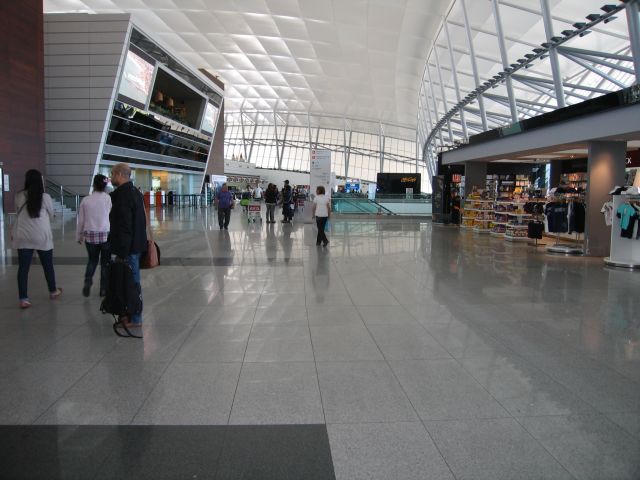Montevideo En Route to Pucon Chile
We’re back in Montevideo again, taking care of a few things before catching our flight to Temuco, Chile. Checking in at Punta Carretas Shopping Center we see that, here it is the first part of November, and they are all ready for the Christmas Holidays.
It is spring again in Uruguay. Not quite sleeve-less or even jacket-less weather but the sun in shining, the deciduous trees are in leaf, the air is fresh, the tourists have not yet arrived. A good time to come to Uruguay.
However, we are not venturing to the beach, assuming the water is still pretty cold.
One thing we notice here is that costs are much higher than when we first arrived in Uruguay six years ago. If you are on a tight budget, looking for a low-cost lifestyle in South America, we think you might want to look elsewhere. You have many choices.
 Above: One section of the relatively new Montevideo Airport.
Above: One section of the relatively new Montevideo Airport.
Uruguay is a great country and you’d have a hard time dragging some expats out of Uruguay–cost or no! The banking here is sound. People from many countries come to Uruguay to do their banking. You can open an account here as a tourist whereas in some South American countries you have to hold legal residency first.
You can buy gold in Montevideo as well. Gales (pronounced GAH-lays) is the major seller of gold and they have several branches. You can often see their armored trucks traversing the city. You can also rent storage here. Sometimes there is a safe box (here called a “cofre”) available at one of the banks, or at Gales, but not often. There is also a private vault facility right next door to the Banco Republica in the Punta Carretas Shopping Center in Punta Carretas. Bus 121 will take you there from downtown Montevideo.
The picture above of the Montevideo Airport today is far removed from the air field where we landed seven years ago and hurried down the stair steps they rolled up against the plane for us to disembark in the rain and run across the field to the building . It is one of the many modernizations in the area.
If you want to see a graph of the difference in costs in housing in various Latin American countries, you can do that at: Comparison of Housing Costs in South America. We sincerely appreciate the subscriber who sent this item from the economic section of El Pais, one of the major newspapers in Uruguay. It is in Spanish but a picture really IS worth a thousand words!
We like Uruguay. It is a stable country with a good financial reputation. At one time it was a very inexpensive place to settle. But Uruguay has been moving ahead. They are establishing themselves as an international IT center and have made several serious upgrades in their infrastructure. I would not call them “first world” but they are moving in that direction. So it’s no surprise that costs are rising in Uruguay. Usually we have to pay for what we get.
Many Uruguayans are taking the boat across the river to Buenos Aires to shop since prices are so attractive there by comparison. And for those with U. S. dollars, Argentina is getting cheaper all the time. In case you’re wondering, the more the Argentina peso falls, the better the exchange rate for U. S. dollars IF you know where to exchange them.
For example, checking the “dollar blue” rate today we see that it is $7.91 pesos per $1 U.S. The “official” Argentina exchange rate if you exchange normally, will be $5.94 pesos per $1 U.S. Inflation in Argentina is serious, but things are still cheap if you go there with dollars. All Uruguayans have to do to get dollars for an Argentina shopping spree is go to their local Uruguay ATM machine.
Then, in Buenos Aires, there are people all along Calle Florida, the prime tourist shopping area in downtown Buenos Aires, who are offering to exchange pesos for dollars at the blue rate. You can check the official exchange rate in Argentina here: Official Argentina Exchange Rate, and you can look for the dollar blue rate here: Blue Dollar Exchange Rate
Incidentally, the blue rate is technically illegal. So far I don’t see that affecting where people do exchanges.However, there have been some arrests of illegal money changers in Buenos Aires. Of course we do not advocate anything that is illegal. This information is entirely informative regarding the economies and the local customs in the two countries!
Having commented on the higher costs in Uruguay, we know expats living in Uruguay who love it here and wouldn’t dream of going anywhere else. We also like Uruguay ourselves and think it is well worth considering. Little Uruguay isn’t a backwater of Argentina any more. And for those who need to find lower-cost jurisdictions there are other good choices. We welcome disagreement and/or discussion in comments from those sold-on-Uruguay folks who disagree with the idea that prices have risen significantly, if there are any–which would surprise us. And if you think Uruguay is well worth the cost, tell us why you think so. And if you know a country that you think is better, tell us which one and the reason.
DO U.S. EXPATS HAVE TO SIGN UP FOR “AFFORDABLE HEALTH CARE?”
Here at Four Flags Journal we think we have yet another reason for living Internationally–Obamacare.
According to Yahoo and other news sources, you do not need to sign up for, nor are you eligible for, the new health care, or its premiums, if you are not a resident of the U.S. And so what is the test of residency? If you are in the U.S. 180 days in any single year, you must comply. There are exemptions–if you are a member of an Indian tribe, a religion that exempts you for conscience reasons, and a few others.
If you want to read the IRS version of minimum requirement you can do so here: I.R.S Questions and Answers on Obamacare. If you are really ambitious you can download a PDF version of the entire law and read it for yourself here: Get PDF Version
We look forward to greeting you again, next time . . . from Chile! Until then . . .
Arlean
email: info@fourflagsjournal.com
copyright Four Flags Journal 2013



Leave a Reply